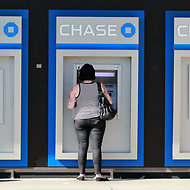TOKYO — Japan’s economy grew at a robust annualized pace of 3.5 percent in the first quarter, preliminary data showed, the first sign that the bold monetary and economic policies of Prime Minister Shinzo Abe were starting to bear fruit.
Japanese growth came to 0.9 percent for the January-to-March period compared with a year ago, driven by higher household consumption and exports, government data showed. That beat market expectations of 0.7 percent for the quarter, or 2.8 percent for the annualized pace.
Exports grew 3.8 percent, pushed higher by strong shipments of cars and other manufactured goods to the United States on the back of a weaker yen, offsetting a slump in exports to China and Europe.
Personal consumption, which makes up the largest part of Japan’s gross domestic product, grew 0.9 percent, as consumer sentiment brightened amid signs of an economic recovery.
The solid pace, which came after two quarters of contraction and a quarter of just 0.2 percent growth, appeared to point to the beginnings of a long-awaited turnaround in the world’s third-largest economy, after the United States and China. “It is a sign that the Abe administration’s economic policies are starting to show results,” the economics minister, Akira Amari, said.
The latest numbers have come as early validation for Mr. Abe, who took office in December, and has used what has been called a three-arrowed bid to lift Japan out of its long deflationary slump. He has focused on an aggressive monetary policy that has flooded the economy with cheap money, major fiscal spending and reforms to make the economy more competitive.
Under Mr. Abe, the central bank has sought to double its monetary base and to generate inflation of 2 percent by 2014. This first arrow has been accompanied by a devaluation of the yen by some 20 percent in the last six months, which has been a boon for exporters. Exporters from Toyota to Sony have reported a rebound in profit in the first quarter of 2013, thanks in good part to the policy.
In recent days, however, concerns have grown over rising interest rates in the government bonds market, which could threaten Japan’s monetary policy. Japan is vulnerable to rising borrowing because of its high public debt burden, which is twice the size of its economy.
Still, investors have piled into Japan’s stock market, emboldened by expectations of rosy corporate profits and an economic recovery. The Nikkei stock index has risen by an astonishing 46 percent since Mr. Abe took office.
Japan is also getting a boost from the second arrow, more fiscal spending. Mr. Abe pushed through an emergency stimulus package of 10 trillion yen in February, and has followed up with a 92.6 trillion yen initial budget for 2013, which Japan’s Parliament approved late Wednesday.
Economists say that for the economy to keep growing, the third arrow will be crucial: mainly structural reforms that aim to make the economy more competitive, for example by making Japan’s labor market more flexible and lowering barriers to trade.
“For the rally to continue and be fundamentally driven, Abe must convince the market that his ‘third arrow’ will benefit Japan’s underlying economy,” the UBS economists Daiju Aoki and Toru Ibayashi said.
Article source: http://www.nytimes.com/2013/05/16/business/global/japans-economy-growing-at-3-5-annualized-rate.html?partner=rss&emc=rss

